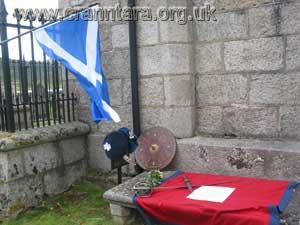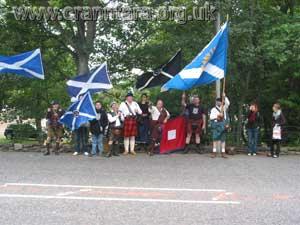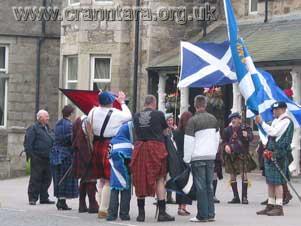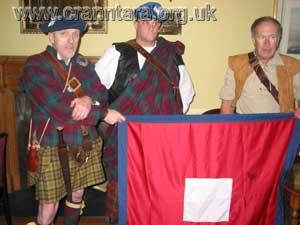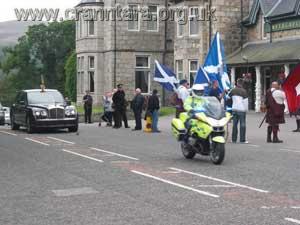In commemoration of Peter Grant [The Auld Dubrach] and The Raising of the Jacobite Standard in 1715.
Beginning at the Old Saint Andrews graveyard in the shadow of Braemar Castle, group representatives from Crann Tara, Siol Nan Gaidheal and Clann Gaidhealach gathered to pay respects to Peter Grant [The Auld Dubrach]. The kirk in which we met is itself full of history dating back to the 8th Century.
In the 8th Century a meeting took place between Bishop Acca of Hexham and Angus, King of the Picts. The Bishop was fleeing from his see and carrying with him relics of St Andrew. As a result of this meeting the bishop built a church and dedicated it to St Andrew. The site of this church was close to where Braemar Castle now stands about half a mile east of the village of Braemar, it is believed to be the first church in Scotland dedicated to St Andrew, who is now the Patron Saint of Scotland. (The blue flag with diagonal white bands is known as St Andrew's Cross.) The relics were later moved to the town in Fife now known as St Andrew's but to this day the local Catholic Church in Braemar is dedicated to St Andrew. The church remained on its original site until a larger church (the present one) was built within the village of Braemar in the mid 19th Century. The site of the original church is now occupied by the family vault of the Farquharsons. Not buried in the Kirkyard is the body of Black Colonel John Farquharson whose name is linked to the Colonel's Bed in Inverey. His request to be buried at Inverey was ignored and he was buried in Braemar. But after repeated burials the coffin was each time found above ground, so it was finally reburied in Inverey.
In the kirkyard is the grave of Peter Grant the man we had come to pay our respects to. Born in 1714, he was captured at the Battle of Culloden but escaped from Carlisle Castle while awaiting trial. Living to an old age he became known as Auld Dubrach, because of the name of the croft he was born in. When George IV visited Edinburgh he heard the story of 'his oldest subject and oldest rebel' and granted him a pension of a guinea per week on his 100th birthday. He was presented to the monarch in Edinburgh, who exclaimed "Ah, Grant, you are my oldest friend", to which old Dubrach replied: "Na, na, your majesty, I'm your auldest enemy". On his death he was thought to have been the oldest surviving Jacobite who had fought for the rebels' side. Sadly, Old Dubrach didn't enjoy the privilege for long as he died in 1824 aged 110 years.
Saying a few words regarding the history of Peter Grant we laid some white roses over his stone and took a few pictures in remembrance.
Leaving the kirkyard we made our way up towards the village where the Standard of 1715 was raised. The village of Braemar was extremely busy as it was the same weekend as the Highland Games and the sound of the pipes and drums could be heard everywhere, within the village itself lies the ruins of Kindrochit Castle, which we paid a brief visit too before parading ourselves around the village to the curiosity of the tourists etc. Making our way back towards the Invercauld Hotel we came across a street performer who we got to play his version of Johnny Cope and was rewarded for his efforts.
When entering Braemar on the A93 heading from Aberdeen, there stands the impressive looking Invercauld Hotel. Directly across the road from the hotel entrance stands a large stone erected by the Aboyne Field Club, which commemorates the Raising of the Standard, although this is not the site where the Standard was actually raised this was a few yards away where the hotel stands today and a brass plaque inside one of the rooms marks the correct spot. Unfortunately the plaque on the stone erected by the field club seems to emphasise the fact that the plaque was unveiled by Queen Elizabeth II on her coronation year rather than more extensive information regarding the Raising of the Standard itself, by putting in bold letters unveiled by Elizabeth Queen of Scots, which is inaccurate in itself as you have to be crowned as such to be so.
As we gathered outside the Hotel all plaided up and with our flags etc we created a lot of interest with tourist and onlookers alike and we all answered questions to what we were actually doing. The police also shared a particular interest into what was going on, but perhaps this was only because the Queen was due to pass at any moment, but after a brief history lesson to them as well they seemed happy enough. After speaking with quite a few folk outside the hotel we went into the hotel to the room where the plaque marking the spot is and gave a brief history of the event, which included the events leading to the standard being raised, those present at the raising itself and what happened to some of those after the raising and their journey in the 1715 until the collapse at Sheriffmuir. As the Queen was due to pass, we went back outside to make our presence known to her in a symbolic and derogatory way. .
The ironic thing about this event is the Queen being patron and guest of the games in Braemar, particularly when the games date originates from the date of the raising of the Standard, a Standard which was raised in defiance of George I the ancestor of the present day Queen.
Anyhow after a brief protest of the above by turning our backs, we retired to the comfort of the Invercauld Hotel to toast the Auld Dubrach, Peter Grant.
With our presence in Braemar over the weekend, we have left tourists and locals with something to ponder over now realising that there was another event which took place on September 6th.
By Jim Singer
|

